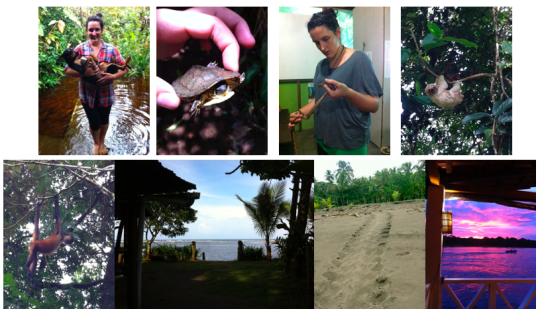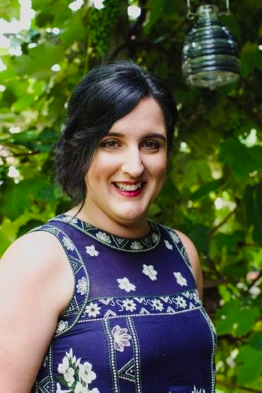by Megan Joyce
Just kidding. I know what you’re thinking, this is a really weird twist on one of those jokes. Not exactly, but close. Wanderlust, biodiversity and the main rule of improv (“Yes, and…”: two small, but essential, words that promise to accept received cues and build on them further) do intersect for me, and at a really specific time in my life. In the fall of my second year of university, I was both in the midst of heartbreak and the recipient of a somewhat mysterious email. The email had been forwarded to the entire student body; it was a mass inquiry, a call to action: ‘Are you interested in Linguistics? Do you like apes? Are you fluent in French? Would you like to study Kanzi?’ – a volunteer research position was in need of being filled. Having promised myself to be more open to opportunities after a recent relationship had ended, I quickly applied to the position and googled who or what a ‘Kanzi’ happened to be. Just in case you’re wondering, Kanzi is an adult male bonobo who was famously reared, from birth, immersed in the English language. As an adult he uses lexigrams, or pictures that represent words, to communicate with human caregivers).
Fast forward six months. I had been studying Systemic Functional Linguistics at Glendon College, York University, and watching videos of the bonobos and their caregivers, dreaming and wishing and hoping I might one day get to meet them; interact with them. Seemingly, against all odds, one of my professors asked if anyone would be interested in volunteering at the ape sanctuary in Iowa that summer. “They are rather short staffed,” he said. Now, this precise moment marked a turning point in my life. I have always daydreamed of jungles, where the sky is hidden by the high canopy trees, reading about explorers and scientists who set out to discover the unknown. “Would anyone be interested in volunteering this summer with the apes?” echoed in my ears. I looked around and I raised my hand. Why was no one else reacting? I couldn’t believe it. I said yes. I was terrified and excited all at once.
Since, I have practiced raising my hand on numerous occasions, saying yes again and again. This has led me to the English countryside of East Sussex, where I lived a version of a Jane Austen-esque summer: frolicking in meadows, surrounded by endless bluebells, and giant dogs, all the while studying the native flora and fauna in a countess’ backyard.
It has led me to the Costa Rican rainforest, where I observed the dinosaur-like Leatherbacks nest along the beach. Non-invasively monitoring the nesting sea turtles contributes to conserving biodiversity; here, it helped deter poachers from digging up freshly laid nests. My days were spent following paths in the rainforest, looking for evidence of mammals. I recorded tracks, looked for leaf tents, tried to spot or listen for monkeys. Once I even witnessed an armadillo foraging in the early morning! Sometimes I completed these surveys while trekking through water up as high as my waist.
Here are some photographs of the countryside in East Sussex:

The first one is a picture of bluebells in bloom, blanketing the ancient woodlands in May. The middle photograph is the golden-hour sun shining through into a woodland pond. The last image is of my friend Lotti and three of her Leonberger dogs. We often took them for walks in the forest and meadows, stopping to identify flowers or insects.
And here’s a collage of photographs I took in Costa Rica while volunteering at the Canadian Organization for Tropical Education and Rainforest Conservation (COTERC). Unfortunately, less than a week into my three-month internship sand got into my camera and ruined it. Luckily another Torontonian came to the station and brought me one from home.

The top left photograph proves that dogs can dislike jungle flooding as much as the rest of us. The second image on top is a young garden turtle we found near base. The third image misleads viewers, showing a calm, cool and collected me helping with snake measurements. It took me the entire summer to get the courage to handle a snake, and I’m proud to say I did not get bit! (Note: all snakes were returned to where they were picked up, using GPS data points taken at the time of collection) The last image on top is of a three-toed, baby sloth. Sloths are members of the Xenarthra superorder (along with armadillos and anteaters) and you can easily tell this three-toed one apart from a two-toed counterpart because it has darker bandit markings around the eyes. On the bottom there is an image of a spider monkey (left), a view of the Caribbean Sea, turtle tracks left from a nesting green sea turtle. Finally, there is a view of my favourite sunset from the last night of my stay.
More recently, this trio has led me to move to a new city and undertake graduate studies. Over the summer, I was able to observe a large group of Japanese macaques (Macaca fuscata) on the island of Awaji, in Japan. It was wonderful to be able to witness first-hand the unique qualities and behavioural ecology of this particular group, while conducting research that will be the basis for my Master’s project.

These are some photographs from the fieldwork I did on Awaji Island, Japan. The first photograph shows one of the Japanese macaques participating in my multi-destination foraging experiment this summer. The goal for the array is to see how the monkeys move through the space. The second image shows a juvenile monkey speedily running through the array to sneak a sweet potato reward. Finally, the third photograph is of an adult male who is punching one of the deer. Sometimes the males will initiate direct contact with a deer if it approaches the food table too closely.
The rule of improv is to react to cues from your teammates with the approach: “Yes, and…”. For me, this philosophy pushes me outside of my comfort zone, toward my goals. Together, with my love for biodiversity and science, it helps me to slowly fulfil my curiosity, to satiate my love of learning and, hopefully, foster a career relating to my passions.

Megan Joyce is an MSc student under the supervision of Dr. Sarah E. Turner at Concordia University in Montreal. She first became interested in primates when she worked with the language ape Kanzi and his bonobo family during her undergraduate degree at York University. This research led to collaborations that have been presented at international conferences. Currently, she is researching the influence of social and non-social factors (e.g. disability) on the decision-making strategies in foraging, within a group of Japanese macaques on Awaji Island, Japan.

0 Comments